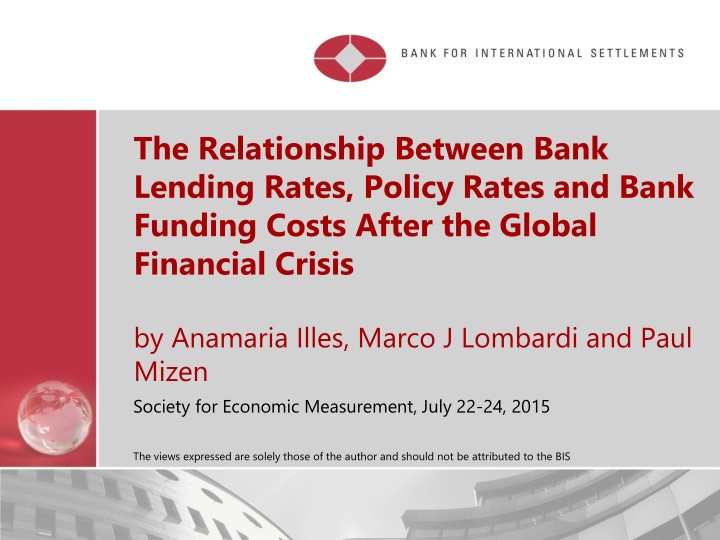
Bank Lending Rates, Policy Rates, and Funding Costs Post Crisis
Explore the relationship between bank lending rates, policy rates, and bank funding costs after the global financial crisis. Understand the discrepancies in rate adjustments and the development of a weighted average cost of liabilities for banks through different funding options and types.
Download Presentation

Please find below an Image/Link to download the presentation.
The content on the website is provided AS IS for your information and personal use only. It may not be sold, licensed, or shared on other websites without obtaining consent from the author. If you encounter any issues during the download, it is possible that the publisher has removed the file from their server.
You are allowed to download the files provided on this website for personal or commercial use, subject to the condition that they are used lawfully. All files are the property of their respective owners.
The content on the website is provided AS IS for your information and personal use only. It may not be sold, licensed, or shared on other websites without obtaining consent from the author.
E N D
Presentation Transcript
The Relationship Between Bank Lending Rates, Policy Rates and Bank Funding Costs After the Global Financial Crisis by Anamaria Illes, Marco J Lombardi and Paul Mizen Society for Economic Measurement, July 22-24, 2015 The views expressed are solely those of the author and should not be attributed to the BIS Restricted
Key Issues The global financial crisis prompted central banks in many countries to cut short-term policy rates to near zero levels after the Lehman collapse in September 2008 Based on the pre-crisis relationship between bank lending rates and policy rates, it would have been reasonable to expect lending rates to have fallen by similar amounts. But lending rates did not fall as much as policy rates did 2 Restricted
Short term lending and policy rates 3 Restricted
Long term lending and policy rates 4 Restricted
Developing a bank funding cost We construct a weighted average cost of liabilities for banks, which reflects the increase in the cost of funds that they have experienced. It comprises a volume-weighted average of the rates at which banks can obtain finance: = j ijt ijt it r w WACL 1 J = where rijt are the rates on the different component liabilities that the banks use to provide funds, and wijtare the weights on those rates based on the component share in total liabilities for the banks in each country. 5 Restricted
Options for developing WACL Option 1: Outstanding cost of funding Option 2: Marginal cost of funding assuming that they keep composition of the balance sheet unchanged Option 3: Marginal cost of funding Our baseline approach is option 2. 6 Restricted
Types of WACL Short-term assuming a maturity of 1-year or less Long-term assuming maturities longer than 1-year, with an average of 5-years Banks fund themselves through: Deposits Securities Central bank operations Covered bonds Others.. 7 Restricted
Weights Based on MFI balance sheets data Weights: short-term WACL Weights: long-term WACL Deposits by MFIs less than 1-year in maturity Deposits by private non-financial sector less than 1-year maturity Short-term securities other than shares Central bank operations Deposits by MFIs more than 1-year in maturity Deposits by private non-financial sector more than 1-year maturity Long-term securities other than shares Central bank operations Covered bonds 8 Restricted
Weights of the short term WACL 9 Restricted
Weights of the long term WACL 10 Restricted
Data description Banks have a substantial deposit base in most countries, over 90 percent of total funding in the short-term and 70 percent of total long-term funding (Table 1). Conventional bonds comprise a small share of short-term funding, while they account for approximately 15-30 percent of funding in the long term. The volume of covered bonds outstanding is not large, but has grown since the crisis. Exceptions are Germany and Spain. Equity issuance is excluded 11 Restricted
Adjusted WACL Adjusted stocks-based WACL. Option 2 methodology is adjusted for the long-term WACL calculation by shifting weight of long-term securities to covered bonds. 12 Restricted
Interest rates Interest rates used are based on new transactions data. Interest rates: short-term WACL Interest rates: long-term WACL Interbank overnight rates Deposit rates with maturities up to 1-year for the private non-financial sector 1-year interest rate swap + 1-year CDS of selected banks Central bank policy rate Interbank 1-year rate Deposit rates with maturities over 1-year for the private non-financial sector 5-year interest rate swap + 5-year CDS of selected banks Central bank policy rates Covered bonds yield to maturity 13 Restricted
Bank funding costs and policy rate 14 Restricted
Bank funding costs and policy rate 15 Restricted
Estimation by pooled mean group (PMG) estimator We take yit, (the lending rate), and xit, (the driver of the lending rate i.e. policy rate or the WACL). Assuming an ARDL model = = 0 1 P Q = + + + y y x e it ip it p iq it q i it p q we rewrite as a stacked set of N individual equations relating yit and xitfor groups i = 1,2, N over the time period t=1,2, T as 1 1 P Q = + + + 0 + + 1 Y Y X Y X , 1 , , i i i i i ip i p iq i q i i = = 1 p q where Yi = (yi1, yiT) , Xi = (xi1, xiT) ,1= (1, , 1) , ei = (ei1, eiT) are all T x 1 vectors of observations, ones and residual errors,and is the first difference operator. 16 Restricted
Results Data are non-stationary according to Im-Pesaran-Shin tests. Cointegration relationships exist for the full sample for the WACL(stock) and WACL(flow) vs lending rates with a few exceptions. NO cointegration exists for policy rates vs lending rates on the full sample. In the case of policy rates the null hypohtesis of no cointegration is rejected more often PMG estimates imply 100bp WACL(stocks) funding cost for banks 85-89bp in lending rates. long-term lending rates are consistently less responsive than short-term lending rates. 17 Restricted
Results Main messages (continued) Results for WACL(flows) are not statistically different from those reported for WACL(stocks) despite different weights. Taking all 11 countries PMG estimates imply short-term lending rates and WACL(stocks) relationships are fairly similar across the three groups of countries Hausman test 18 Restricted
PMG estimates of pass through WACL (stock) 19 Restricted
PMG estimates of pass through WACL (flow) 20 Restricted
PMG estimates policy rates 21 Restricted
Results contrast with policy rates Pass-through estimates with policy rates: 100bp in policy rates 52-96bp in lending rates. The range of values is wider. In many cases the pass through estimate is lower. There is a structural break in policy rates and cointegration breaks down even when we allow for a structural break. A Hausman test rejects the null of equality of coefficients across countries (rejecting the PMG restriction). 22 Restricted
Robustness checks Findings are robust for: Different weighting schemes Different country sub-samples Different times sub-samples 23 Restricted
Questions? 24 Restricted


